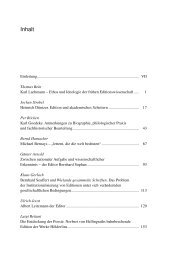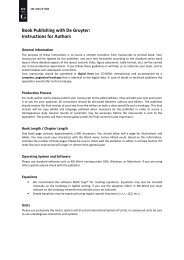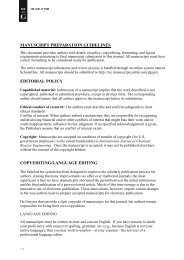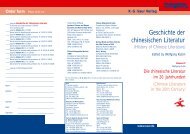The basic color terms of Russian* - Walter de Gruyter
The basic color terms of Russian* - Walter de Gruyter
The basic color terms of Russian* - Walter de Gruyter
Create successful ePaper yourself
Turn your PDF publications into a flip-book with our unique Google optimized e-Paper software.
80 /. Davies and G. Corbett<br />
only just achieves this dominance score; half <strong>of</strong> the respon<strong>de</strong>nts, the<br />
minimum required, used the term for the same tile, and this is reflected<br />
in the very low specificity in<strong>de</strong>x. It appears that although many people<br />
know the term sirenevyj 'mauve', there is relatively low agreement over<br />
its use.<br />
3.3. Combined analysis <strong>of</strong> all measures<br />
Table 6 shows the rank or<strong>de</strong>rs on each <strong>of</strong> the measures given in the<br />
previous sections, for the 18 most frequent <strong>terms</strong> <strong>of</strong>fered in the list<br />
experiment (<strong>terms</strong> <strong>of</strong>fered by more than a third <strong>of</strong> the sample) together<br />
with the two versions <strong>of</strong> the rank or<strong>de</strong>rs on the hierarchy for each term,<br />
<strong>de</strong>pending on whether goluboj 'light blue' is accor<strong>de</strong>d equal rank with<br />
sinij 'dark blue' — column 10 — or whether it is treated as a secondary<br />
<strong>basic</strong> term — column 11. In addition to the assumptions we have ma<strong>de</strong><br />
about golub<strong>of</strong>s position, we have also assigned the probable non<strong>basic</strong><br />
<strong>terms</strong> equal ranks, with scores lower than all those <strong>of</strong> the <strong>basic</strong> <strong>terms</strong>.<br />
<strong>The</strong> final two columns <strong>of</strong> Table 6 give the mean <strong>of</strong> the ranks across the<br />
measures for each term, and the rank or<strong>de</strong>r <strong>of</strong> these mean scores.<br />
It can be seen that just two <strong>of</strong> the measures are successful at separating<br />
the <strong>basic</strong> from the non<strong>basic</strong> <strong>terms</strong>: both for frequencies in lists and for<br />
specificity, the highest ranked non<strong>basic</strong> term has a lower rank than the<br />
lowest ranked <strong>basic</strong> term. <strong>The</strong>se two measures also have the highest<br />
correlations with the hierarchy scores given in columns 8 and 9: the<br />
correlations range from tau = .64 for the second hierarchy measure with<br />
the list frequency measure, to tau = .73 for the second hierarchy measure<br />
paired with specificity; all four correlations are significant at p
















